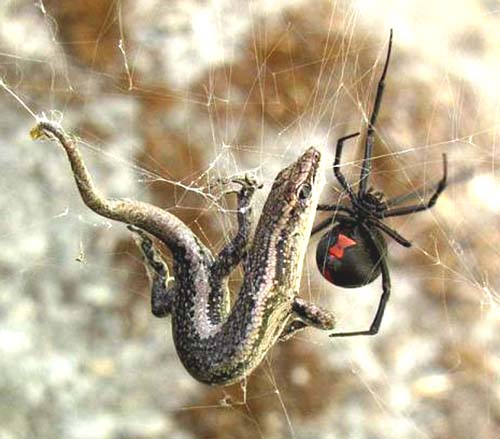
Spiders are not insects, although they belong to the same phylum of animals as insects. Spiders have four pairs of legs and two body segments, they do not have wings or antennae. Spiders belong to the class Arachnida while insects belong to the class Insecta. Spiders are closely related to scorpions, ticks and mites. There are about 37,000 of known species of spiders in the world. Spiders vary in size from the 10 inched bird-eating tarantulas of the rain forest to as small as pin point (0.37 mm) as in Patu digua, a spider of Columbia and they vary widely in colour. The Spider Wasp is the biggest predator of Spider species. The blood of a Spider is light blue in color. They are found everywhere; in soil, under rocks, on grasses, on tree branches, in caves, in your garden or even in your restrooms. Many spiders only live for one or two years, but some like tarantulas live for about 20 years.
Silk: Spiders have glands that make silk. The strongest material in the world is considered as the silk that spiders create. Scientists have not been able to recreate this design even with all the available technology that we have today. The silk is used to capture prey in elaborately woven webs, to wrap and protect eggs and as a bungee cord to move from place to place.
Venom: Spiders are carnivorous and feed on living prey. They crush the prey with processes on the pedipalps, and the chelicerae and have glands that can inject a venom. The bite of some large spiders are painful, but most species are too small to break human skin and only a few are dangerous to humans. Black widow spider is one of the poisonous species, they are nonaggressive and bite humans only in defense. Their painful bite is followed by faintness, difficulty in breathing; although the bite sometime leads to death. Spider venom are neurotoxins, which affects the victims nervous system, typically resulting in paralysis. Some injects cytotoxins that affect the cell tissue. There were about 100 reliably reported deaths from spider bites.
Benefits to humans: Cooked tarantula spiders are considered a delicacy in Cambodia, where the venom gland and outer hairs are removed before cooking. Most spiders are helpful to humans by killing insects harmful to animals and plants. Spider venoms are found to be less polluting alternative to conventional pesticides as they are deadly to insects. Possible medical uses for spider venoms are being investigated for the treatment of cardiac arrhythmia, Alzheimer's disease and strokes. Fine transparent spider silk fibers are used by scientists working on optical communications to introduce minute diffraction patterns over propagating N-slit interferometric signals.
Contributed by: Dr. J. Benjamin Franklin, Scientist, NIOT, Port Blair.